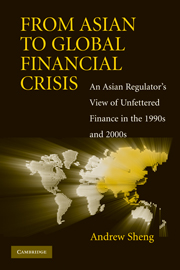 From Asian to Global Financial Crisis
From Asian to Global Financial Crisis Book contents
- Frontmatter
- Contents
- List of Figures
- List of Tables
- Acknowledgements
- Introduction
- 1 Things Fall Apart
- 2 Japan and the Asian Crisis
- 3 The Beam in Our Eyes
- 4 Banking: The Weakest Link
- 5 Washington Consensus and the IMF
- 6 Thailand: The Karma of Globalization
- 7 South Korea: Strong Body, Weak Heart
- 8 Malaysia: The Country That Went Its Own Way
- 9 Indonesia: From Economic to Political Crisis
- 10 Hong Kong: Unusual Times Need Unusual Action
- 11 China: Rise of the Dragon
- 12 From Crisis to Integration
- 13 The New World of Financial Engineering
- 14 What's Wrong with Financial Regulation?
- 15 The Global Financial Meltdown
- 16 A Crisis of Governance
- From Asian to Global Crisis: Chronology of Notable Events
- Abbreviations and Acronyms
- Bibliography
- Index
9 - Indonesia: From Economic to Political Crisis
Published online by Cambridge University Press: 05 June 2012
- Frontmatter
- Contents
- List of Figures
- List of Tables
- Acknowledgements
- Introduction
- 1 Things Fall Apart
- 2 Japan and the Asian Crisis
- 3 The Beam in Our Eyes
- 4 Banking: The Weakest Link
- 5 Washington Consensus and the IMF
- 6 Thailand: The Karma of Globalization
- 7 South Korea: Strong Body, Weak Heart
- 8 Malaysia: The Country That Went Its Own Way
- 9 Indonesia: From Economic to Political Crisis
- 10 Hong Kong: Unusual Times Need Unusual Action
- 11 China: Rise of the Dragon
- 12 From Crisis to Integration
- 13 The New World of Financial Engineering
- 14 What's Wrong with Financial Regulation?
- 15 The Global Financial Meltdown
- 16 A Crisis of Governance
- From Asian to Global Crisis: Chronology of Notable Events
- Abbreviations and Acronyms
- Bibliography
- Index
Summary
Jang Harus Dibabat dan Harus Dibangun (What to Clear Away and What to Build).
~ Indonesian author Pramoednya Toer (1962)If the Asian Crisis was an accident, Indonesia must be the worst casualty. From 1 July 1997 to its lowest point in June 1998, the Indonesian rupiah fell 85 percent against the U.S. dollar, much more than the Thai baht (56 percent), the Korean won (55 percent) and the Malaysian ringgit (48 percent) at their respective worst points. Furthermore, in 1998 Indonesian GDP fell 13.1 percent, the worst Asian decline compared with Thailand (10.5 percent), Malaysia (7.4 percent) or South Korea (6.9 percent).
The Indonesian tragedy is that it was the Asian crisis shocks that exposed a banking crisis that in turn precipitated a political crisis that ultimately led to the end of President Suharto's 32 years of rule on 21 May 1998. The country's IMF programmes, officially initiated on 8 October 1997, ended nine years later following Indonesia's early repayment of all its debts to the Fund in October 2006, but not before four Indonesian Presidents had come and gone.
Above all, it was the Indonesian people who suffered the most from this tragedy. I first visited Indonesia in the mid-1970s when it was still very poor. Indonesia is my favourite country to visit because of its long history, diverse culture and the fact that I admired how the nation steadily grew out of poverty.
- Type
- Chapter
- Information
- From Asian to Global Financial CrisisAn Asian Regulator's View of Unfettered Finance in the 1990s and 2000s, pp. 218 - 252Publisher: Cambridge University PressPrint publication year: 2009


